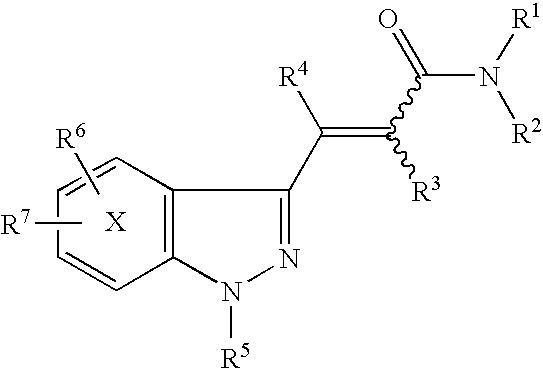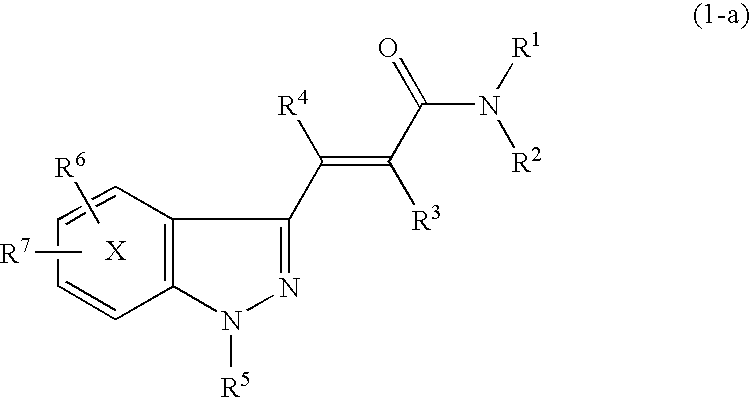Indazole acrylic acid amide compound
a technology of acrylic acid and compound, which is applied in the field of indazole acrylic acid amide compound, can solve the problems of insufficient use of indazole, inability to reduce the number of deaths, so as to prevent or treat cardiac arrhythmias and prevent thromboembolism
- Summary
- Abstract
- Description
- Claims
- Application Information
AI Technical Summary
Benefits of technology
Problems solved by technology
Method used
Image
Examples
example 1-1
[0149]
[0150]Compound 1 (200 mg) was suspended in anhydrous THF (7 ml), and thereto was added triphenylphosphine (279 mg) with stirring, and to the mixture was slowly added N-chlorosuccinimide (156 mg) under ice cooling. To the mixture was added a solution of Compound 2 (345 mg) in THF (0.5 ml), and the mixture was allowed to warm up to room temperature and stirred for 3 hours. To the mixture was added 10% aqueous citric acid solution, and the mixture was extracted with chloroform, dried over anhydrous sodium sulfate, and then concentrated under reduced pressure. The residue was purified by silica gel column chromatography (eluent: 3% methanol-chloroform) to give Compound 3 (121 mg) as a pale yellow crystal.
[0151]MS (APCI): 349 [M+H]+
example 1-2
[0152]
[0153]Compound 1 (270 mg) and triphenylphosphine (385 mg) were suspended in THF (6 ml), and thereto was added N-chlorosuccinimide (214 mg) under ice cooling and the mixture was stirred at room temperature for 1 minute. To the mixture was added a solution of Compound 2 (357 mg) and diisopropylethylamine (465 μl) in THF (5 ml) under ice cooling, and the mixture was stirred at room temperature for 2 hours. To the reaction mixture were added water and a saturated aqueous sodium bicarbonate solution, and the mixture was extracted with ethyl acetate. The extract layers were combined, washed with brine, dried over anhydrous sodium sulfate, and then concentrated under reduced pressure. The resulting residue was purified by silica gel chromatography (eluent: 3% to 10% methanol-chloroform gradient), concentrated under reduced pressure, and then the resulting mixture was crystallized from ethyl acetate-hexane (1:1) to give Compound 3.
[0154]MS (APCI) 363 [M+H]+
example 1-3
[0155]
(1) Compound 1 (1.502 g) was dissolved in THF (70 ml), and thereto were sequentially added triphenylphosphine (2.510 g), then N-chlorosuccinimide (1.279 g) with stirring under ice cooling. The mixture was stirred for 60 minutes under ice cooling, and thereto was added dropwise a solution of Compound 2 (2.391 g) and diisopropylethylamine (2.777 ml) in THF (30 ml) over 30 minutes. After the addition, the mixture was allowed to warm up to room temperature and stirred for 25 hours. To the reaction mixture was added water with stirring under ice cooling, and the mixture was extracted with ethyl acetate. The extract layers were combined, washed with a saturated aqueous sodium bicarbonate solution and brine, and dried over anhydrous sodium sulfate. The solvent was distilled away under reduced pressure and the resulting residue was purified by silica gel column chromatography (eluent: 1 to 2% methanol-chloroform) to give Compound 3 (1.877 g) as a pale brown oil.
[0156]MS (APCI) 421 [M+...
PUM
| Property | Measurement | Unit |
|---|---|---|
| temperature | aaaaa | aaaaa |
| temperature | aaaaa | aaaaa |
| temperature | aaaaa | aaaaa |
Abstract
Description
Claims
Application Information
 Login to View More
Login to View More - R&D
- Intellectual Property
- Life Sciences
- Materials
- Tech Scout
- Unparalleled Data Quality
- Higher Quality Content
- 60% Fewer Hallucinations
Browse by: Latest US Patents, China's latest patents, Technical Efficacy Thesaurus, Application Domain, Technology Topic, Popular Technical Reports.
© 2025 PatSnap. All rights reserved.Legal|Privacy policy|Modern Slavery Act Transparency Statement|Sitemap|About US| Contact US: help@patsnap.com



